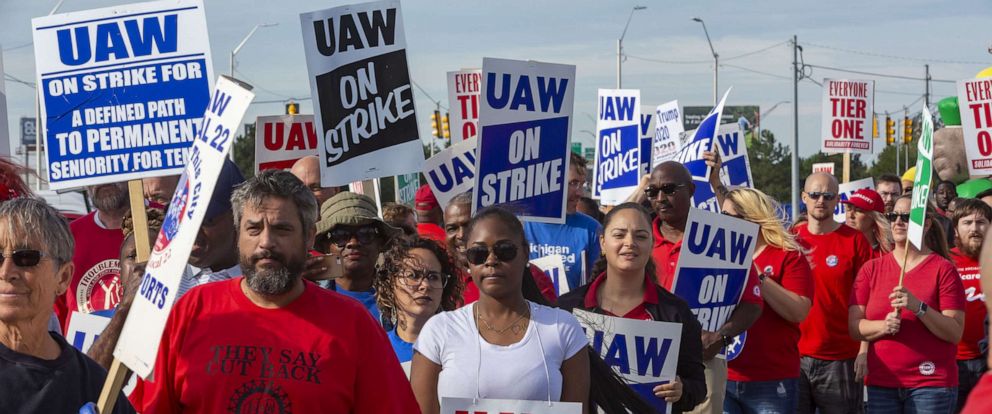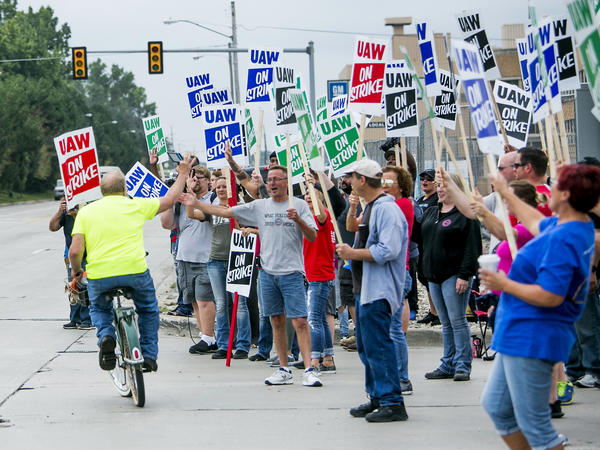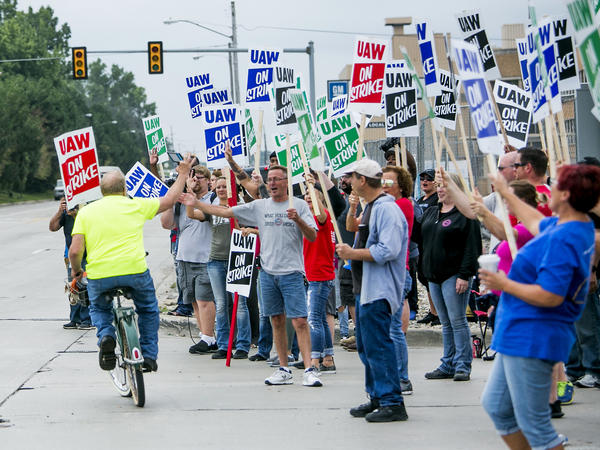
After a 40-day strike, a new four-year deal between the United Auto Workers and General Motors was approved. The contract was supported by 57% of the labor union. It includes an $11,000 bonus per member, annual raises and more affordable healthcare. General Motors still plans to close three factories in the United States.
The United Auto Workers union emerged with substantial wage increases of 3 percent in the second and fourth years and 4 percent lump sum payments in the first and third years, similar to what the union obtained in 2015. Even larger gains are in store for those in a category called “in progression,” the lower scale of a two-tier wage system negotiated in 2007 when the Detroit automakers were financially reeling.
Workers hired after that date, about a third of the overall work force, started at about half the pay of veteran employees and had no prospect of reaching the top wage, currently $31 an hour. Over the course of the new contract, the disparity will be phased out, and those with four years’ experience will rise along with more senior workers to the new top level of $32 an hour. In addition to pay increases, G.M. workers will get bonuses of $11,000 for ratifying the contract. They will continue to pay 3 percent of their cost of health care, well below the percentage that G.M.’s salaried workers contribute.
There were also rewards for temporary workers, about 7 percent of G.M.’s union work force, who will have a path to permanent employment after three years. About 900 of them will become full employees in January, the union said, and 2,000 more by 2021.
It also won commitments to new G.M. investments in United States factories. As part of the new contract, the company pledged to invest $7.7 billion in its United States plants, and another $1.3 billion in ventures with partners, providing a measure of job security. G.M. will put $3 billion toward overhauling the Detroit-Hamtramck plant, which had been scheduled to close in January. Three-quarters of the 700 workers there voted in favor of the contract.
At the same time, the agreement allows G.M. to close three idled factories permanently, including one in Lordstown, Ohio, eliminating excess manufacturing capacity at a time when auto sales are slowing. It also puts the company in a more stable position if the economy goes into a recession. The closing of the Lordstown plant was one of the main sticking points for some workers voting against the contract. “We did everything that G.M. ever asked of us at times of concessions,” said Bill Goodchild, a member of Local 1112 in Lordstown. “We feel we deserve a product.”
About 48,000 United Auto workers walked off the job over one month ago, making it the longest national strike at GM by United Auto Workers in nearly 50 years. The contract finally ends a strike that many estimate has cost GM $1.75 billion in losses. “We delivered a contract that recognizes our employees for the important contributions they make to the overall success of the company,” G.M.’s chief executive, Mary T. Barra, said in a statement.
Read more

As the GM strike continues, picketers received some bad news from Tennessee. A striking United Auto Worker union member was hit by a car and killed outside the General Motors plant in Spring Hill where workers were maintaining an active picket line. The UAW said in a statement that 55-year-old union member Roy McCombs “tragically lost his life today on a picket line standing up for a better life for himself and his coworkers.”
McCombs was hit on a bridge outside the GM plant as he was crossing the road to get to the picket line around 6 am. McCombs was transported to a hospital and pronounced dead in the emergency room, said Lt. Jeremy Haywood of the Columbia police department in Columbia, Tennessee. The driver who hit McCombs was cooperating with investigators.
Local 1853 Chairman Mike Herron said, “Sergeant Orlando Cox from the Columbia Police Dept. will be releasing a statement shortly that will describe this event as an innocent tragic accident. He has asked that everyone refrain from going to the South Gate for safety reasons. He requested that any vigils be held at our union hall and not in the vicinity of this accident — to ensure the safety of the participants.”
Herron said the UAW local sends thoughts and prayers to McCombs’ family as well as the driver, “who was on her way to drop off her kids at the day care center located at the south exit when this tragic accident occurred.” All strike activity has ended at the South Gate of the plant and no pickets will be set up there in the future, Herron said. Also, the UAW crisis team has been called in and will meet personally with UAW members that were on the South Gate at the time of the accident as well as McCombs’ coworkers on the third shift.
UAW members at Spring Hill have taken part in picketing as part of the union’s nationwide strike against GM since Sept. 16 though it’s been contentious from the start. Maury County sheriff’s deputies in Tennessee had arrested nine protesters on Sept. 18 when they refused to stop blocking the south entrance to the plant. A 10th arrest came when someone drove recklessly through plant’s entrance, sheriff’s officials said.
A court in Tennessee granted GM’s request to prevent UAW picketers from blocking the entrance to the factory. The order was in effect until Oct. 8. It followed several arrests at the plant since GM’s 46,000 UAW workers went on strike. “After dialogue failed to stop the incidents of harassment, violence and vandalism by a few people, we had to take necessary actions to protect everyone involved,” GM said at the time. The order barred the UAW and its members from blocking entrances, detaining vehicles, creating obstructions on roadways or “assaulting, intimidating, falsely imprisoning, harassing or destroying the property of GM employees” and others at the plant.
Read more

As the GM strike entered its fifth week, the United Auto Workers union announced that picketing workers can expect an extra $25 a week from the union’s strike fund. GM, on the other hand, can expect its dealers to face increased difficulty in sourcing certain replacement parts, while others worry about the prospect of subpar inventory. The UAW’s bargaining team presented a new comprehensive offer to GM as talks continued. In addition to the slightly boosted strike pay, the UAW also lifted the cap on cash earned at outside jobs. Starting Sunday, workers moonlighting at other jobs can keep the full strike payment, regardless of what they made in their alternate gig. Strike payments are typically clawed back on a dollar-for-dollar basis after the worker passes the $250 threshold.
In addition to a host of other issues, health care sits near the top of UAW concerns in this latest round of talks. With GM looking to downsize in an era of shrinking auto sales and economic uncertainty, offering generous health benefits represents a major cost to each company. An agreement was reached between GM and the UAW that keeps the previous health care arrangement intact. The agreement keeps the arrangement where workers cover just 3 percent of their health care costs — an agreement GM briefly abandoned earlier in the bargaining process. The automakers would undoubtedly seek concessions in other areas but unions are not prone to accept concessions lightly.
In the tentative deal with General Motors, the union won on many of its goals, including a path to permanent employment for temporary autoworkers, a faster route to top pay for workers hired after 2007 and a flattened pay structure for permanent employees, who would reach $32.32 per hour by the end of the four-year deal. The biggest obvious loss for the union is the continued closure of the Lordstown Assembly plant in Ohio.
The Lordstown Assembly Plant in Ohio is to remain closed, as will transmission plants in Warren and Baltimore; and a parts distribution center in Fontana, California, will close during the term of the contract. The union said it negotiated assistance packages for workers at Lordstown, Warren and Baltimore transmission plants, including $75,000 payments for eligible production workers and $85,000 for skilled workers who retire. There are also buyout options for those not eligible to retire.
Some other features of the deal include UAW-represented GM workers will get a bonus of $11,000 upon ratification of the deal and temporary workers will get $4,500. GM will invest $7.7 billion in U.S. facilities to create or retain 9,000 jobs. There will be wage increases of 3% in the second and fourth year of the contract, with 4% lump sum payments in the first and third years. Temporary workers, who have been paid $15-$19 an hour with inferior benefits to permanent autoworkers, get a path to a permanent role starting next year. Part-time workers get a path to regular status starting in 2021. These workers also get improved paid and unpaid time off. By September 2023, all permanent manufacturing employees will be at $32.32 per hour.
The tentative deal is far from perfect and the UAW is trying to persuade union workers to accept the deal. Experts said General Motors has lost more than $1 billion in profits, while line workers have lost nearly $750 million in income. With the state of Michigan are losing tax dollars, there’s a growing sentiment that something has to change soon and many hope this deal will finally end the strike.
Read more

General Motors has told the UAW that it will continue to pay for health coverage for striking workers. GM told the union after it went on strike Sept. 16 at company sites nationwide that it was kicking health care costs to the union, a move that UAW leaders said blindsided them, even though they had anticipated picking up those costs at some point through the strike fund. GM stated they have chosen to work with their providers to keep all benefits fully in place for striking hourly employees, so they have no disruption to their medical care, including vision, prescription and dental coverage.
The strike is the UAW’s first since the Great Recession and GM’s federally induced bankruptcy in 2009. Experts say as the strike continues toward the end of its second week, it has left a lasting economic impact. Strike pay is $250 per week, but it won’t be distributed until the 15th day of picketing. The starting wage for temporary production workers at GM is $15.78 per hour, which is about $630 per 40-hour week. Top-paid production employees, however, earn $30.46 per hour, or about $1,218 per week.
The UAW says that temporary workers are union members doing the same work as permanent employees, but they get half the pay and far fewer benefits. The union wants those workers to get a path to being permanent and get pay and benefits that more closely match their permanent counterparts, even when they’re temporary. GM counters that employing temporary workers is good for permanent employees because they enable the full-time staff to take time off. Hiring temps also gives the company flexibility to scale up production for new models and combat employee absenteeism
The UAW is also fighting for the retention of a health insurance plan in which workers pay about 4% of the costs, an improved pension and assurances that GM — the maker of Buick, Cadillac, GMC and Chevrolet — will not close four plants in Maryland, Ohio and Michigan.
The strike has affected GM facilities in Ohio and Ontario not represented by the UAW. All told more than 3,200 GM workers represented by other unions have been laid off. On Monday, the automaker notified 525 employees at its DMax Ltd. engine plant in Moraine, Ohio, that they temporarily were laid off. GM suppliers, such as Magna International Inc. and Nexteer Automotive, also said they temporarily have had to lay off employees during the strike.
Analysts agree that the cost of the strike is mounting daily for both GM and striking workers, as well as for the broader community. Anderson Economic Group, an East Lansing-based consultant, said in a new analysis Thursday that GM probably has lost profits of $113 million so far, and is now losing money at the rate of $25 million a day. As talks continue toward a UAW-GM contract, negotiations have entered a new stage and moved to the main table. In recent days, talks have been confined to smaller committees as the two sides struggled to hammer out details.
Union leaders have argued that GM workers deserved a bigger slice of the company’s profits, which they say have totaled $35 billion in North America over the last three years. Union members are calling for fair wages, saying for every $1 a GM employee made, CEO Mary Barra made $281. As the strike enters its 3rd week, the national impact will continue until an agreement is reached.
Read more

On September 15th, nearly 50,000 members of the United Auto Workers (UAW) launched a strike, walking out of over 50 General Motors facilities. Workers say GM continues to deny employees’ demands for fair conditions and compensation despite leading the company to record profits following bankruptcy and a federal bailout. The nearly 50,000 full-time and temporary workers represented by the UAW make up about half of its workforce.GM workers say they are pushing for a more equitable contract that will guarantee better wages for new hires, stronger health-care benefits and more job security. Workers are forgoing their paychecks during the strike, though the UAW will pay them $250 a week from its strike fund.
GM has made over $30 billion in the past six years, since recovering from its 2009 bankruptcy. Although they received profit-sharing checks that totaled $52,500 for the same period, workers want pay raises that will show up year after year. They gave up cost-of-living pay raises and made other concessions to keep the company afloat during its 2009 bankruptcy, and now they want to be repaid. Longtime workers have received only two raises since 2010. Workers hired after 2007 still make less than older workers, and the union wants to erase that gap.
The company is facing a global auto sales slowdown and also says health care costs are too high, and it wants to cut labor costs so they are closer to U.S. factories owned by foreign competitors. Senior GM workers now make around $30 per hour, but with benefits, it adds up to $63 per hour. Total labor costs run an average of $50 per hour at the foreign plants. The car giant has moved to close a handful of production facilities in the United States in recent years despite strong profitability margins. GM made $8.1 billion in profit after taxes last year but announced the closure of four factories, scuttling thousands of jobs. GM says it has offered to make $7 billion in investments and create 5,400 jobs, including introducing electric trucks, opening a battery cell manufacturing site and investing in eight existing facilities.
The strike has effectively halted GM’s production in the US and just a day after the strike, GM responded with a letter announcing they had cut off health insurance for the nearly 50,000 people on picket lines across the country. GM spokesman David Barnas said the decision to cut workers’ health care was a standard practice during stoppages, likening it to the cessation of worker paychecks. A spokesperson for the UAW stated that they would cover the striker’s health-care fees under COBRA in the interim from the pool of money it keeps for strikes. Employee dental and vision plans will not be covered during the strike.
The effects of the strike have been felt quickly, when GM dismissed 1,200 workers from an assembly plant in Ontario, Canada just three days after the strike started. GM has said the temporary layoffs were the result of parts shortages in the United States because of the strike. The factory had produced full-size pickup trucks. Analysts say GM could be losing as much as $50 million to $100 million a day from the stoppage. 
Read more








